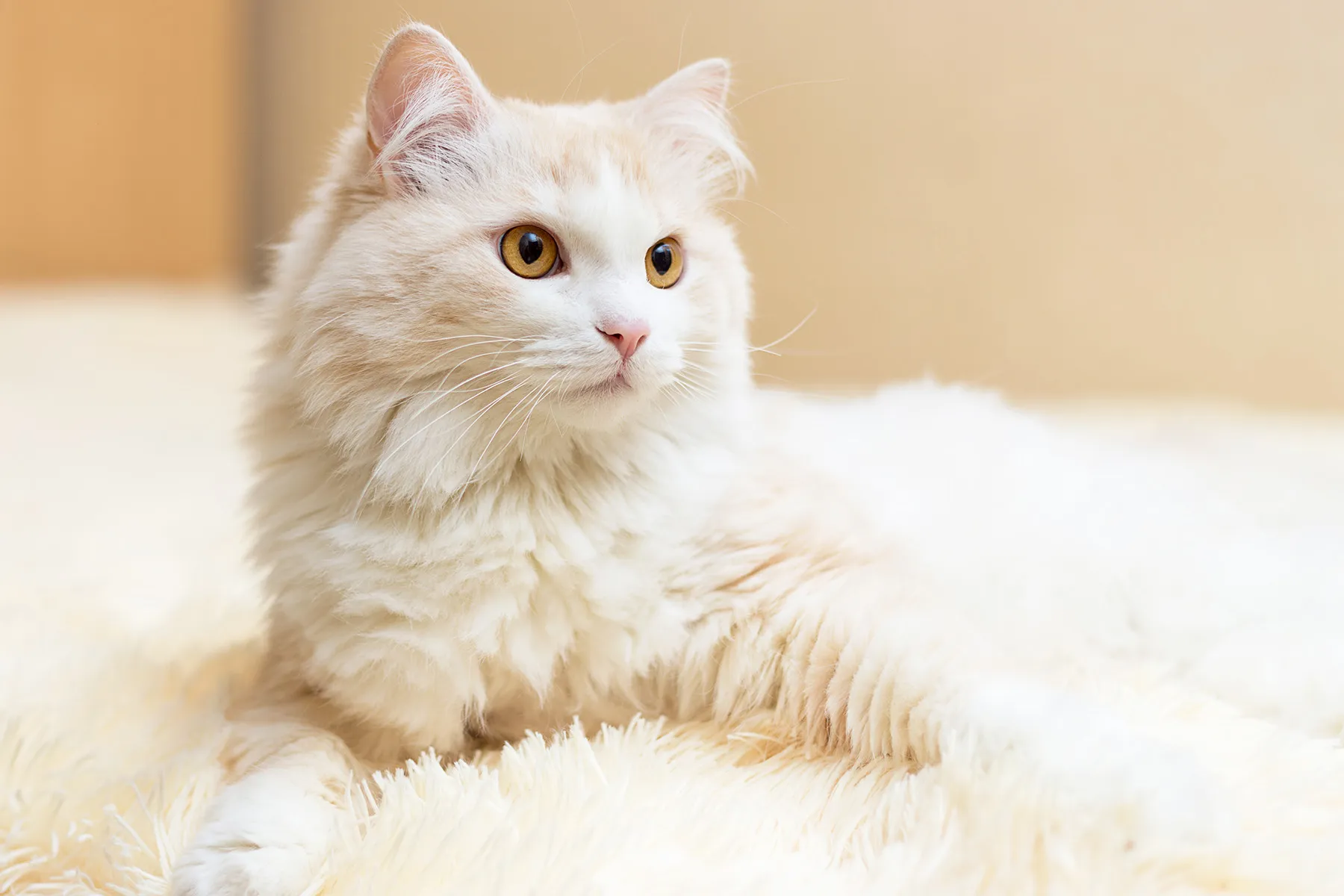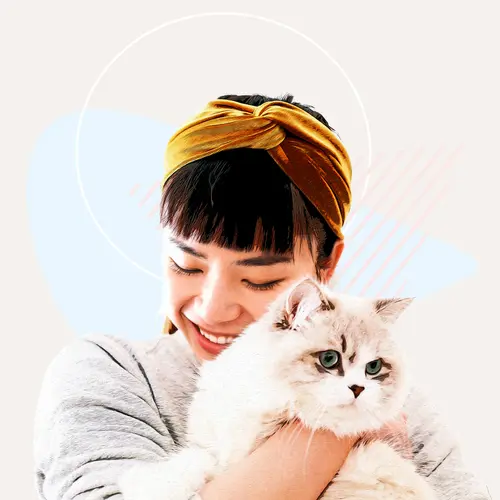
Turkish Angora cats are a naturally occurring cat breed. They’re graceful animals and sometimes called ballerinas.
These cats are a fine mix of cuddly and energetic. They’re attentive to their owners and don’t like feeling left out. If you adopt a Turkish Angora cat, they’ll quickly become a beloved and energetic member of your family.
Characteristics of a Turkish Angora Cat
Body size. The Turkish Angora size is smaller than many breeds. Healthy cats should weigh an average of five to 10 pounds. Talk to your veterinarian if you’re concerned that your cat is too far underweight or overweight.
Body shape. Turkish Angora cats are very fine-boned, but they’re not necessarily a delicate breed. All their legs are long, but the back ones are slightly longer than the front. They end in small, oval feet that ideally have toe tufts.
Other Turkish Angora characteristics include small to medium-sized wedge-shaped heads. Their muzzles are a smooth continuation of this shape. Their ears are large, with slight points at the top, and set high up on their skulls.
The cats also have long tails that taper slightly toward the end.
Lifespan. The Turkish Angora lifespan can be quite long. The cats live an average of 15 to 20 years. This means that you need to be prepared for a long life with your pet before choosing to bring one home, especially if you adopt them when they’re still a kitten.
Coat. Turkish Angoras have long, silky coats. They’re technically considered a semi-longhaired breed.
Their coats are sometimes described as gossamer-like because they’re so fine and soft. The breed’s traditional coat color is white, but many different colors and patterns exist today.
Common colors and patterns include:
- Black
- Blue
- Red
- Cream
- Tortoiseshell
- Spotted tabby
- Bi-colored
Eyes. Turkish Angora cats have large, walnut-shaped eyes. There isn't a relationship between their eye color and their coat color. Common eye colors include:
- Blue
- Amber
- Odd — when one eye is blue, and the other is amber
Personality. The Turkish Angora personality is very outgoing and affectionate. They tend to be very interested in their owners’ lives and will follow you around the house just to see what you’re up to.
These cats demand lots of love and affection. If you ignore them for too long, they’ll likely act out to make sure that you notice them.
They’re sometimes referred to as the border collies of the cat world because of how sociable they are. These cats are likely to greet your guests at the door and try to get as much attention from them as possible.
Caring for a Turkish Angora Cat
Grooming. Turkish Angora cats are fairly easy to groom. Despite their semi-long coats, they don’t form mats or tangles easily. You should brush them or comb them once a week to keep their coats shiny and looking their best.
They do shed when the weather transitions from winter to summer. Brush them more frequently at this time to prevent the dead hairs from accumulating on your clothes and furniture. Brushing your cat will also reduce hairballs because they’ll swallow less loose fur.
To ensure that your cat remains at their healthiest, you should also regularly check their teeth and ears. Brush their teeth weekly to prevent dental disease.
Feeding. You should consult your veterinarian for the most accurate feeding advice for your pet. You need to make sure that your cat is getting the right nutrient balance for their stage of life. In general, it's best to find a type of high-quality kibble that your pet enjoys.
Also, make sure that your cat is getting enough water. You can talk to your veterinarian if you're concerned that your cat is dehydrated. Try tricks like using a flowing fountain and leaving water in multiple locations.
Exercise and mental stimulation. Turkish Angora cats are an incredibly athletic breed. They’re very active and need a reasonable amount of playtime to keep them at their mental and physical best.
The cats have strong hunting instincts and will happily chase toys throughout your house. Leave out crumpled papers or small mice for them to play with at their leisure. They’re also very agile. They do well in the sport of feline agility because they have both speed and smarts.
Veterinary visits, medications, and immunizations. You'll want to find a veterinarian when you first adopt a pet. Annual visits to your veterinarian will ensure that your cat lives their happiest, healthiest life.
Make sure that your cat has their full set of core vaccinations. This includes vaccinations for:
- Feline distemper
- Feline herpes virus
- Calicivirus
- Rabies
Some cats will also need additional non-core vaccinations. Talk to your veterinarian to see which of these is best for your cat.
Cats can also get fleas and develop other problems like heartworm. Talk to your veterinarian about flea medications and preventatives. Unfortunately, there isn't a treatment for heartworm in cats. But your veterinarian can recommend a preventative.
Health Problems To Watch For with a Turkish Angora Cat
In general, Turkish Angoras are a very healthy breed. There aren’t any health problems that are only found in this breed.
But you could still encounter some complications throughout your pet's life. Make sure that your cat sees a veterinarian at least once a year. This will help you catch conditions early and ensure that your cat lives its healthiest, happiest life.
Some of the most common Turkish Angora health issues include:
- Hereditary deafness. The same gene that causes the white coloration and blue eyes in this breed can also cause deafness. Watch your cat to see if they can respond to verbal cues. Most cats can adapt to being deaf to the point humans might not notice. This isn’t a serious medical issue, just something to be aware of for this breed.
- Hereditary ataxia. This problem with your cat’s nervous system can lead to problems with their movement, like an unsteady gait. In this case, the condition will be present at birth. The exact treatment depends on the severity of the condition. Your veterinarian will need to assess your cat in person to decide the best plan for your pet.
- Hypertrophic cardiomyopathy. This is the most common form of heart disease in felines. It’s caused by a thickening of the heart muscles. Symptoms include trouble breathing, vomiting, decreased appetite, and weakness — particularly in their rear limbs. There’s no cure for this condition. Treatments, like prescription medications, can help manage symptoms and prevent additional complications.
Special Considerations for a Turkish Angora Cat
There are a few things that you should keep in mind before making a Turkish Angora part of your family. First of all, these cats are a purebred line. For a time, all longhaired cats were referred to as angoras. Since the early 1900s, breeders have tried to be more careful with this term, so there isn’t confusion between other breeds and the official Turkish Angora.
The cats are typically good with strangers. Your pet may even welcome guests at the door with you and act like an attentive host or hostess throughout the visit.
They’re also good with children and seniors — if you’re looking for a motivated, curious pet. They do well in households with other pets, including dogs. But this cat will need to ensure that they’re their pack’s alpha. Your other pets should be prepared to submit to this cat's will.
Turkish Angoras do like to climb. You’ll be better off in the long run if you provide them with high-up places to climb and perch, preferably surfaces that are the highest in the room. Otherwise, you’ll likely find them trying to get up to places they shouldn’t.
They’re also clever and can learn to open cabinets and doors. You may need to baby-proof openings that you don’t want your cat exploring.
History of Turkish Angora Cats
Turkish Angora cats are a natural breed that has existed for hundreds of years in Turkey. They’re from Ankara and are named for the previous name of this capital city, Angora. The earliest written record of Turkish Angora cats comes from France in the 1500s.
By the start of cat fever in the late 1800s and early 1900s Europe, this breed was widespread throughout the continent. They were heavily used to bolster the Persian breed. Turkish Angoras almost died out because they were exclusively bred into Persian programs.
Turkey stepped in to save this national treasure. They created a specific Turkish Angora breeding program at the Ankara Zoo. This ensured the continuation of the breed and is the ultimate source of all the lines found outside of Turkey. The program specifically focused on white cats.
In the 1950s, American military members saw the cats at the zoo and spread awareness of the breed. After a lot of debate, Colonel and Mrs. Walter Grant were allowed to take two of the cats to America — an amber-eyed female named Yildiczek and an odd-eyed male named Yildiz.
These two cats were the foundation of the U.S. breeding program. Over the next few decades, more cats were sent out from the Turkish program to support the breed's American development. The breed finally became well-established in America in the 1970s.
In 1968, the Cat Fanciers’ Association (CFA) started registering this breed. They became eligible for championship status in 1972. At first, only all-white cats were permitted, but they expanded the category to include all colors two years later. All Turkish Angoras registered in the CFA need to be able to trace their lines back to Turkey.
